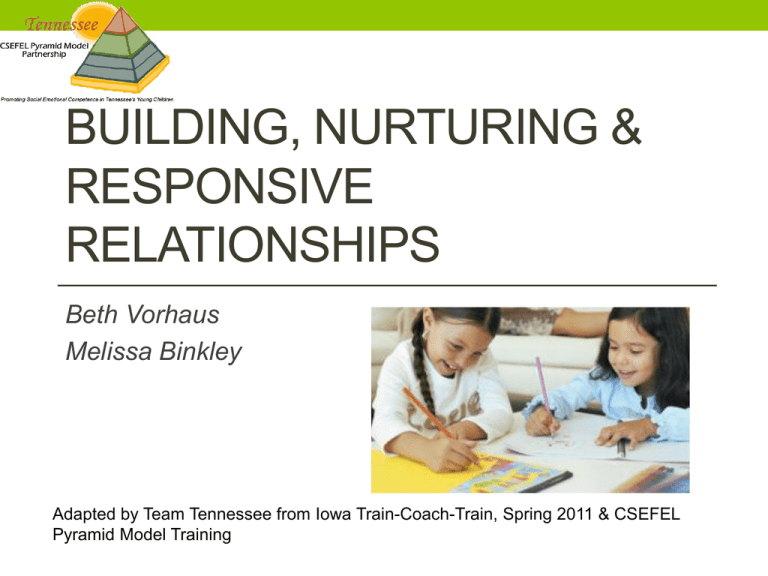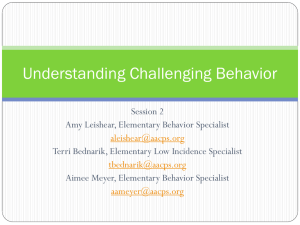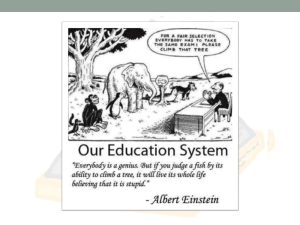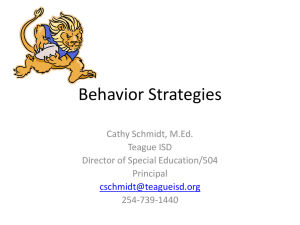Building Positive Relationships
advertisement

BUILDING, NURTURING & RESPONSIVE RELATIONSHIPS Beth Vorhaus Melissa Binkley Adapted by Team Tennessee from Iowa Train-Coach-Train, Spring 2011 & CSEFEL Pyramid Model Training INTERVENTION PREVENTION → → ←PROMOTION Pyramid Model Benefits of Positive Relationships with Adults • The relationships that we build with children, families, and colleagues are at the foundation of everything we do. It is important to build these relationships early on rather than waiting until there is a problem. • •Parents and other colleagues (such as mental health providers and therapists) are critical partners in building children’s social emotional competence. We should all work together to ensure children’s success and prevent challenging behavior. Benefits of Positive Relationships for All Children • Helps each child feel accepted in the group • Assists children in learning to communicate and get along with others • Encourages feelings of empathy and mutual respect among children and adults • Provides a supportive environment in which children can learn and practice appropriate and acceptable behaviors as individuals and as a group Benefits of Positive Relationships for Children with Challenging Behaviors • Children with the most challenging behaviors especially need these relationships, and yet their behaviors often prevent them from benefiting from those relationships. • Adults’ time and attention are very important to children, and we need to be sure that we are giving them that time and attention at times other than when they are engaging in challenging behavior. What is Attachment? • The first attachment occurs with primary caregivers in the first 9 months of life • After age 2 children have the capacity to build multiple relationships with caregivers independent of their primary attachment Function of Attachment • Survival, safety, and protection • Support and a secure base for the development of: • Cognitive development • Ego/sense of self • Resilience • Bonding • Self-regulation • Social development Function of Attachment: Brain Development Video: Positive Relationships “Every child needs one person who is crazy about him.” -Uri Bronfenbrenner Activity: Hot Button From PIES Workbook, Laura Riffel, 2009 Handout 1 Challenging Behaviors have a Purpose! • Challenging behavior usually has a message: • • • • I am bored. I am sad. You hurt my feelings. I need some attention. • Children often use challenging behavior when they don’t have the social or communication skills they need to engage in more appropriate interactions. • Behavior that persists over time is usually working for the child. • We need to focus on teaching children what to do in place of the challenging behavior. Discussion: Cultural Differences & Child Behaviors Mean Age Expectation in Months for Milestone Attainment Caucasian Solid Food 8.2 Training Cup 12.0 Utensils 17.7 Finger Food 8.9 Wean 16.8 Sleep by Self 13.8 Sleep all Night 11.4 Choose Clothes 31.1 Dress Self 38.2 Play Alone 25.0 Toilet Trained-Day 31.6 Toilet Trained-Night 33.2 Puerto Rican 10.1 17.1 26.5 9.4 18.2 14.6 14.5 44.2 44.2 24.8 29.0 31.8 Filipino Eat 6.7* 21.9* 32.4* 9.5 36.2* 38.8* 32.4* 33.1* 39.2 12.3* 20.4* 34.2 Mean Age Expectation in Months for Milestone Attainment 16 Carlson & Harwood (2000) Discussion: Cultural Differences & Parent Expectations Behavioral Expectations of Two Groups of Mothers Korean-American Mothers European-American Mothers Believe parents and Children should play together 54% 96% Prefer children play with sex-typed toys (e.g., boys play with trucks) 71% 43% Provide children with many 11% chances to decide (e.g., give child choices) 66% Adjusting Responses to Challenging Behaviors Upsetting Thoughts “That child is a monster. This is getting ridiculous. He’ll never change.” “I’m sick of putting out fires!” Calming Thoughts Upsetting Thought “I wonder if the corner grocery is hiring?” “He ruins everything! This is going to be the worst year of my career.” Calming Thoughts Activity: Reframing Thoughts • Using Reframing Statements Activity • Read the four examples listed and generate two to three other challenging behaviors and how you might reframe each one. • In reframing the challenging behaviors, do not come up with solutions but rather restate the behaviors to make them more manageable. • Be prepared to share your ideas with the large group. Handout 2 How to Build Positive Relationships Be a “Bucket Filler!” Developed by Carol McCloud • “Bucket fillers” generally spread their love and good feelings to others • "Bucket dippers" rob us of happy feelings by refusing to help with a task or by saying or doing cruel things • https://www.bucketfillers101.co m/home.html Discussion: Making Deposits with Children • How do you build relationships with the children in your classroom? • Think of the children with challenging behaviors you currently have or have had in the past – how can you make deposits with Classroom Pictures Birthday Charts Changing Table All About Me Posters Family Treasures Family Flowers My Family Making Group Deposits • • • • • • Greet every child at the door by name. Post children’s work around the room. Have a “star” of the week who brings in special things from home and gets to share them during circle time. Give hugs, high fives and thumbs up accomplishing tasks. Give compliments liberally. Let children make “All About Me” books and share them at Circle Time. Video: Greeting Children by Name Making Individual Deposits • • • • • • • Call a child’s parent in front of them to say what a great day she is having or send home positive notes. Call a child after a difficult day and say, “I’m sorry we had a tough day today. I know tomorrow is going to be better!” When a child misses school tell him how much he was missed. Write on a t-shirt all the special things about a given child and let him/her wear it. Find time to read to individual children or a few children at a time. Play with children, follow their lead. Acknowledge children’s efforts. Video: Individual Deposits Discussion: Making Deposits with Families • How do you build relationships with families? • How can you make deposits with the parents of children with challenging behaviors? Making Family Deposits • • • • • • • • • Keep lines of communication open between program and families Support and encourage parental involvement in activities. Learn from family members about their children, and home and family life. Share resources with parents about how to support the child’s social emotional development. Share positive things the child did at the program (Happy Grams). Conduct meetings with parents in an environment and time convenient for them. Assure parents about confidentiality and privacy rights. Implement activities that bring families together. Acknowledging the good things that parents are doing with their child. Handout 3 Video: Making Family Deposits Discussion: Making Deposits with Coworkers • How do you build relationships with your coworkers? • Think of a coworker with whom you may not always get along – how can you make deposits with them? Making Co-Worker Deposits • • • • • • • • • • Encourage teamwork Provide support Build trust among colleagues Be honest and kind to one another Respect co-workers’ talents and abilities Acknowledge accomplishments Understand and respect each other’s backgrounds Develop a shared vision, goals, and mission Have a sense of humor Build cooperation Activity: Action Planning • Brainstorm a list of 3-5 things you could do to build or strengthen relationships ‾ With children ‾ With families ‾ With co-workers • Share with the whole group • Identify the next steps you are going to take to build stronger relationships with children, families, and colleagues ‾ Note these on your action planning form. • What materials will you need? • What support will you need? Handout 5 & 6 Questions? Melissa Binkley Team Tennessee Program Coordinator Tennessee Voices for Children Mbinkley@tnvoices.org (615) 269-7751 x115 Beth Vorhaus Team Tennessee Assistant Program Coordinator Tennessee Voices for Children Bvorhaus@tnvoices.org (615) 269-7751 x124






